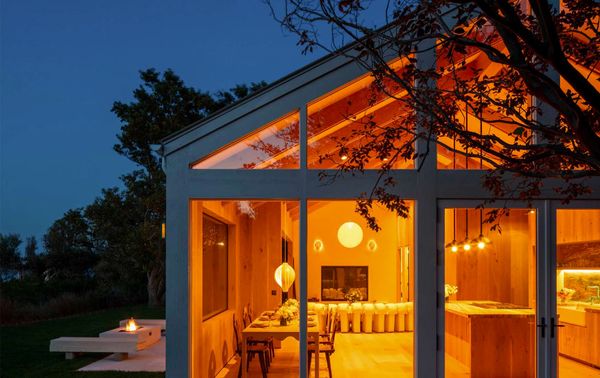
At a Glance:
What Is Dynamic Architectural Lighting?
Understanding Smart Controls and Their Role in Lighting Systems
Benefits of Smart Lighting for Architectural Area Lighting
Application Examples by Environment
How to Implement Smart Controls for Architectural Area Lighting
Dynamic architectural area lighting isn’t just about brightening up a space—it’s about transforming the way we experience it. Imagine having the power to adjust lighting to suit your mood, highlight a specific feature, or completely change the vibe of a room. That’s the beauty of combining smart lighting with thoughtful design.
At the heart of this innovation are smart controls, offering you incredible flexibility and customization. Think about it: no more one-size-fits-all lighting. Instead, you can tailor your setup to perfectly match your needs, whether it’s for a cozy evening or a productive workday.
Curious about how it all works? This guide walks you through everything you need to know—what dynamic architectural lighting is, how smart controls play a role, the top benefits, real-life examples, and practical tips to get started.
Whether you’re an architect designing the next big thing, a designer looking to wow your clients, or a homeowner dreaming of smarter spaces, this guide is here to help. Let’s dive in and see how dynamic lighting and smart controls are changing the way we think about illumination. Ready to light up your world? Let’s go!
Create the Perfect Lighting for Your Home or Business
If you want to impress your visitors or customers with exceptional architectural lighting, be sure to contact the experts at Logic Integration in Colorado.
Talk to an Architectural Lighting Expert TodayWhat Is Dynamic Architectural Lighting?
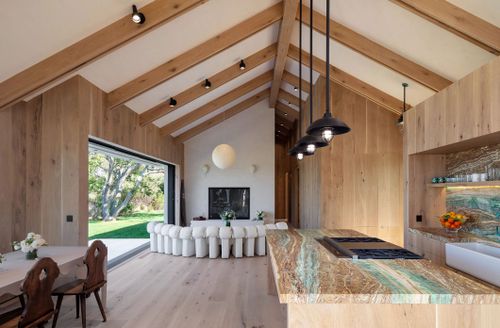
Dynamic architectural lighting is more than just light fixtures. It’s an evolving design element that adjusts to complement environments, enhance functionality, and even influence human experiences. Unlike static area lighting that delivers fixed brightness and color, dynamic lighting is engineered to adapt and change in response to its surroundings or user needs, making it an integral aspect of modern design.
At its core, dynamic architectural area lighting offers the ability to modify brightness, color temperature, and lighting effects. With advanced technologies, it shifts from warm hues to cooler tones or dims to set a softer ambiance, all with precision. Picture a sleek office that uses cool daylight tones to boost productivity during work hours but transitions to a cozy, relaxed glow during evening events. Or imagine an outdoor public plaza where bold lighting colors energize crowds during festivals but subtly adjust to create calming pathways late at night. This adaptability allows spaces to satisfy different functions throughout the day.
Dynamic lighting isn’t simply about looks; it transforms the way people feel, work, and experience spaces. Its ability to connect aesthetic intent with human-centered design is precisely why it’s becoming a must-have in contemporary architecture.
Learn more: Automated Lighting: The Power of Remote Control Lights
Understanding Smart Controls and Their Role in Lighting Systems
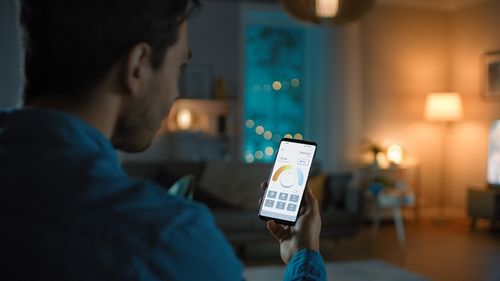
A dynamic lighting system is only as effective as its control framework. Enter lighting control systems—the brain of modern setups. These advanced tools do more than simplify lighting management—they transform how we interact with light. By automating, personalizing, and streamlining operations, smart controls have become essential in modern architecture, enhancing both functionality and user experience.
Smart controls integrate seamlessly with architectural area lighting systems, offering options for brightness, scheduling, and color adjustments through apps, remotes, voice assistants, or IoT platforms. They allow users to easily modify lighting and create environments that adapt in real time. For instance, lights can turn off in empty rooms to save energy or shift tones during the day to mimic natural daylight, boosting mood and productivity. Users can also pre-set scenes for different activities, like a cozy movie night, a workout, or a focused workspace.
Aside from convenience, smart lighting controls play a vital role in energy efficiency and sustainability. By optimizing energy use and reducing waste, they align with green building initiatives, making them key in designing eco-friendly architectural lighting. As technology evolves, smart controls continue to expand their capabilities, offering even greater personalization, efficiency, and innovation.
Key Features of Smart Controls
- Scheduling: Schedule lighting to align with business hours, energy peaks, or special events, enhancing both efficiency and functionality.
- Automation: Motion sensors, timers, and AI allow lighting to adjust automatically, reducing the need for manual input.
- Brightness & Color Management: Dimmable lights and mood lighting controls adapt to tasks, moods, or times of day, promoting health and well-being with circadian lighting that supports the body’s natural clock.
- Remote and IoT Connectivity: Apps and IoT technology enable users to control and monitor lighting remotely, with real-time adjustments and interconnected setups.
Smart controls far surpass traditional systems, offering enhanced functionality, energy savings, and flexibility that outdated switches and dimmers simply can’t match.
Learn more: Smart Shades: Lutron Palladiom vs Triathlon
Benefits of Smart Lighting for Architectural Area Lighting
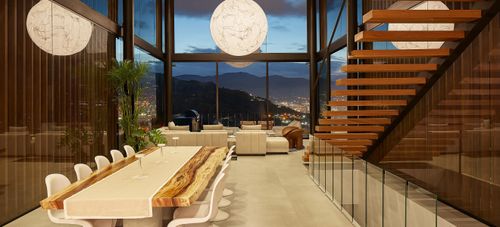
Smart lighting adds value to architectural projects by blending aesthetics, functionality, and technology seamlessly. Here are three key benefits:
Energy Efficiency
Smart lighting conserves energy without compromising performance. Automated features like switching off in empty areas or dimming during daylight cut waste. Sensors ensure lighting is only used when needed, while scheduling syncs with business operations. For instance, outdoor lighting in a shopping district might dim to 50% after midnight while staying bright enough for safety.
Businesses save on energy bills and reduce their carbon footprint—sustainability meets style.
Enhanced Visual Appeal
Lighting doesn’t just illuminate; it shapes how spaces are perceived. Architectural area lighting offers features like gradual transitions, bold colors, or shadows to enhance depth and texture. Imagine a restaurant transitioning from a lively lunch vibe to an intimate dinner setting or a retail store spotlighting seasonal products.
Thoughtful home lighting design turns spaces into dynamic, engaging experiences that leave lasting impressions.
Adaptability for Different Environments
Architectural lighting is flexible and caters to various needs. Offices can balance bright zones for productivity with relaxing atmospheres elsewhere, while event venues can shift lighting for conferences or concerts. A commercial plaza might prioritize bright pathways for safety but transition to mood lighting for evening events.
This adaptability ensures spaces effectively support a range of activities, making it valuable for industries like hospitality and education.
Learn more: How to Create Zones with Smart Outdoor Lighting
Application Examples by Environment

Dynamic lighting and smart controls shine when applied to real-world settings. Here’s how they work across different spaces:
Offices
Circadian lighting in offices boosts productivity and well-being by aligning with natural biological rhythms. It mimics daylight changes, helping regulate energy and mood. Bright, cool lighting energizes mornings, while warmer hues create a relaxed vibe for breakout areas. Meeting rooms benefit from adjustable brightness, tailored for activities like brainstorming, presentations, or formal meetings. By enhancing productivity and employee health, circadian lighting creates a supportive work environment.
Outdoor Plazas
Outdoor area lighting balances decoration and function. A well-lit city plaza attracts foot traffic with decorative lighting designs. Smart controls allow for seamless transitions, enabling day-to-night shifts in tone and brightness.
Retail Settings
Shopping is as much emotional as functional, and dynamic architectural lighting helps retailers stand out while showcasing products. Upscale stores may use soft, warm lights for a luxurious feel, while electronics stores rely on bright, crisp lighting for a modern look. Lighting control also guides customers through aisles or highlights specific promotions.
Beyond Commercial Spaces - Home Lighting Inspiration
Emerging technologies are transforming high-end homes, where personalization is key. Homeowners create custom scenes for yoga sessions, movie nights, or entertaining guests. Circadian lighting aligns with natural rhythms for better sleep and energy, while party modes add vibrant effects to elevate the atmosphere.
How to Implement Smart Controls for Architectural Area Lighting
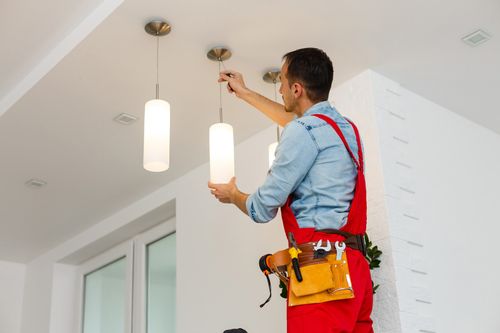
A thoughtful, methodical approach ensures a lighting control system integrates seamlessly and delivers both immediate and long-term value. Here’s how to do it right:
- Assess Project Needs: Evaluate the unique requirements of your project. Collaborate with designers, architects, and lighting engineers to create a solution that balances aesthetics, functionality, energy efficiency, and user experience. This ensures the system enhances the environment while meeting specific goals.
- Choose the Right Systems: Select smart controls that are compatible with current setups but flexible enough for future upgrades. Scalable solutions that integrate with IoT infrastructure keep your investment valuable over time. Features like energy monitoring, automation, and remote access can greatly improve performance and usability.
- Ensure Professional Installation: Proper installation is crucial for reliability and longevity. Hire experienced professionals to ensure components are installed correctly and function as intended. Contact the experts at Logic AV for design and installation guidance. Regular updates and maintenance are necessary to keep the system optimized and aligned with evolving needs.
By following these steps, your architectural area lighting system will enhance functionality and support long-term goals.
Final Thoughts
Ever walked into a space where the lighting just fit—perfectly matching the mood or purpose of the room? That’s the magic of smart lighting for dynamic architectural area lighting. And it’s not just a trend—it’s changing how spaces connect with people.
Think about it: adjusting lighting to match the time of day, setting the mood for a cozy night at home, or creating vibrant energy in a retail store. Smart controls put you in charge. It’s not just about aesthetics either—these systems save energy, boost creativity, and balance style, function, and comfort all at once.
The best part? Architectural lighting doesn’t just make life easier or spaces prettier (though it does both). It’s a step toward sustainability, reducing energy use and cutting carbon footprints. Whether in architecture, urban design, or your own home, architectural area lighting is paving the way for greener, brighter futures. Why not let your lighting work smarter for you? Work with us at Logic AV today!
Architectural Area Lighting FAQs
Architectural lighting enhances the visibility, functionality, and safety of spaces while highlighting the structural beauty of a design. It also promotes energy efficiency through advanced technology, reducing long-term operational costs.
Architectural lighting focuses on functionality, emphasizing visibility, and complementing the structure's overall design. Decorative lighting prioritizes style and ambiance, acting as an aesthetic feature to enhance the mood of a space.
By strategically illuminating key architectural features, this type of lighting shapes the identity of buildings, both day and night. It adds depth and drama, transforming structures into visually captivating landmarks.
Lighting placement, color temperature, and energy efficiency are essential for creating a harmonious balance between functionality and aesthetics. Each element should align with the purpose of the space and the building's architectural goals.
Why Trust Logic Integration?
Logic Integration is a Colorado-based custom integrator, offering a wide range of AV and automation services, for both residential and commercial settings. We partner with leading technology brands to provide you with the latest and most reliable solutions. We’ll collaborate closely with you to understand your needs and preferences, crafting a user-friendly system that complements your space and lifestyle. Our commitment to clean installations ensures all technology blends seamlessly with your environment, minimizing clutter and maximizing aesthetics. At Logic AV, we believe that technology integration is an ongoing process. This is why we offer comprehensive maintenance and support services to ensure any system we install continues to function flawlessly for years to come.
Our team is comprised of experienced, certified professionals with deep technical knowledge and a passion for innovative solutions. Named CTA’s Integrator of the Year, we are fully accredited by organizations such as the Custom Electronic Design & Installation Association, Home Technology Association, and National Association of Home Builders. Ultimately, choosing Logic Integration means trusting your AV and automation needs to a proven, experienced, and customer-focused company. We'll transform your space into a connected, intelligent environment that elevates your everyday life.
Technology Solutions by Logic Integration
As a rapidly developing technology and integration firm, we keep ourselves up-to-date with the latest products, technologies, and industry trends. As a result, our technical team is the most well-trained in the industry, enabling us to effectively improve our clients' communication and entertainment needs. At Logic Integration, we place great emphasis on the quality of audio and visual products as well as our quick response times to service and sales communication. Our experienced technicians are well-versed in the correct installation of smart home products, video solutions, home theater options, and more. Visit us in person or call us at 303-484-8237 to learn more.